MWDI believes that effective resource management of nest box programs cannot occur without good data on nest use and productivity results. Obtaining and analyzing this information is critical to optimize duckling production from a given set of nest box “assets". MWDI’s research focus is generally oriented towards the establishment and use of this statistical base. As MWDI builds its state wide data base of nest box information into the “thousands”, all sorts of statistically significant analyzes will be possible.
While this data base will take years to build and perfect, the use of artificial nest boxes offers many types of “cause and effect” study opportunities that complement these potentially more sophisticated analyses. These studies can be quite simple or complex, but they help reinforce the educational aspects of nature at work.
MWDI has initiated several of research projects and is keen to start others. The principal ones include the following:
Recycled Freon Canisters
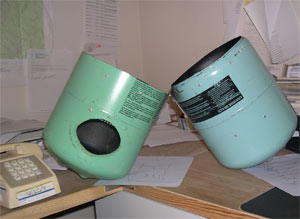 Nest
structures made from these discarded metal canisters (2) have been
used successfully at Federal Refuges in Iowa (Union Slough in
particular) for the past 25 years. The USGS website provides plans
for construction.
Nest
structures made from these discarded metal canisters (2) have been
used successfully at Federal Refuges in Iowa (Union Slough in
particular) for the past 25 years. The USGS website provides plans
for construction.
They are
virtually maintenance free and will last over 20 years. The “all-in”
cost is less than $5 each for assembly hardware.
MWDI raised
concerns about Maryland’s more southerly latitude than Iowa and
whether “our” wood ducks would use them. Most people we’ve spoken to
have universally indicated that the plastic cylinders sold by Ducks
Unlimited did not work.
2005
Research Projects & Results
In
2005, MWDI installed 6 canisters in 4 separate project locations in
Maryland and conducted a heat test placing a box in the shade after
cutting vent holes in it and painting it light beige. The spring was
relatively cool that year and even in July, the inside temperature
of the canister never exceed 96 degrees and the highest inside
temperature was 7 degrees above the outside level. (106 degrees
being the upper limit possible for egg survival.)
Of the 6
field canisters, 5 were used and 4 hatched. The unsuccessful nest
was in full incubation with a normal clutch but the hen was
overwhelmed by an ant infestation and abandoned the nest. Two
canisters were placed in generally high use wood duck areas,
representing new capacity in each project where placed. Of the others,
two were in new project area and two in a moderate use region. This was most encouraging.
2006
Research Projects & Results
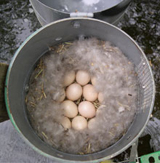 In
2006, 28 canisters were installed although only 18 were determined
to be functional as nesting material had not been provided.
Water conditions were also very poor and many canisters were in dry
habitat that was typically flooded. Of the14 functional nests, 4
were used and hatched. In one project area, 2 new wood and 2
canisters were placed in the same wetland (although visually hidden
from each other) and the wood ducks used the 2 new wood ones and not
the canisters.
In
2006, 28 canisters were installed although only 18 were determined
to be functional as nesting material had not been provided.
Water conditions were also very poor and many canisters were in dry
habitat that was typically flooded. Of the14 functional nests, 4
were used and hatched. In one project area, 2 new wood and 2
canisters were placed in the same wetland (although visually hidden
from each other) and the wood ducks used the 2 new wood ones and not
the canisters.
Conclusions
Field
acceptance is still considered favorable although it is MWDI’s
perception that, other things being equal, in new habitat use areas,
wood ducks will prefer wood over metal if given a choice in the near
term. Field trials will continue.
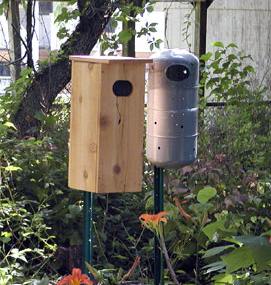 Manufacture
using a plasma cutter will also be tested further as this seems to
be the easiest way to cut off the tops and bottoms and cut out the
entrance hole and bolt holes. Supply of canisters is not a limiting
factor. MWDI has sources defined to make hundreds.
Manufacture
using a plasma cutter will also be tested further as this seems to
be the easiest way to cut off the tops and bottoms and cut out the
entrance hole and bolt holes. Supply of canisters is not a limiting
factor. MWDI has sources defined to make hundreds.
Heat Test Conducted
To independently analyze the heat buildup issue, Donny McKnight, of the
Harford Christian School, agreed to establish a heat test under more
controlled circumstances than that done by MWDI and to monitor a
wooden box in the same environment. Donny’s results will be
published soon. He has documented that heat buildup was not an issue
limiting the prospective widespread use of recycled canisters in a
shaded environment.
Pros & Cons Indicate Longer Term Evaluation
Worthwhile
Freon
canisters are harder to fabricate than wood boxes and they are not
“traditional,” but they are very cheap and the maintenance benefits
are such that longer term evaluation is considered to have real
merit.
Nest Data Quality vs. Time
Reasonably accurate information on nest box productivity is
important, especially in new programs or where a proactive
resource management approach is desired. Productivity results
and nesting behavior can be hard to interpret especially without a
good egg membrane count and to a lesser extent, without
relatively fresh down and unhatched eggs left in their immediate
“post-nest” natural position.
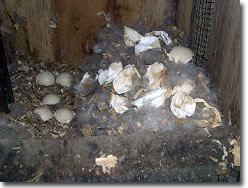 Late winter and early spring inspections often miss or
misinterpret the “clues” left behind as residual nest
information may change. For example, membranes are eaten by
inspects or removed by other nest users, down gets scattered,
wet and matted, old eggs break/get broken or substantially
altered to mask potential nest strife or predation.
Late winter and early spring inspections often miss or
misinterpret the “clues” left behind as residual nest
information may change. For example, membranes are eaten by
inspects or removed by other nest users, down gets scattered,
wet and matted, old eggs break/get broken or substantially
altered to mask potential nest strife or predation.
In more than one project area where interim nest inspections were
initiated as compared to annual, early spring inspections, MWDI
determined that under-counting of duckling production was
substantial. Further, nest strife and snake predation, in
particular, had not been recognized as problems affecting
overall productivity.
In an attempt to document more fully the impact on productivity
estimates that the passage of time causes, MWDI established 75
“control” nests in 2006 where nest productivity is confidently
known. These nest boxes will be checked again in early spring
2007 and another hatch result will be estimated by a different
inspector and the results compared. Unhatched eggs were removed
so it will basically be a membrane versus membrane count.
This research will be expanded to encompass assessment of nest strife
and other qualitative factors to try and document better the
merits of interim and prompt inspections following the nesting
season and to help determine where such efforts are not
necessary.
 For mature nest programs where only one box visit has been made,
MWDI encourages sponsors to conduct a nest maintenance
inspection in mid-late summer instead of early spring to obtain
a reasonably accurate perception of nest results before other
events alter the data. Nest materials can be changed then and
left for the following spring season. The weather is also nicer
and there are more natural things alive to see (and potentially
avoid!).
For mature nest programs where only one box visit has been made,
MWDI encourages sponsors to conduct a nest maintenance
inspection in mid-late summer instead of early spring to obtain
a reasonably accurate perception of nest results before other
events alter the data. Nest materials can be changed then and
left for the following spring season. The weather is also nicer
and there are more natural things alive to see (and potentially
avoid!).
On new programs or in mature programs where actual results are not
really known, an interim inspection mid-nest season and then a
late summer inspection is strongly encouraged to help establish
the overall status of the program. Once this data reference is
known, subsequent inspection frequency and timing can be altered
down to the individual box in many cases.
However, in MWDI’s
brief tenure, there has not been one nest program that has not
been favorably enhanced after conducting an interim and then
another nest inspection in late summer.
Starling Deterrence – Horizontal Nest Box Use - By Cliff Brown
Background
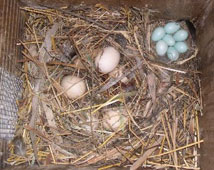 In late 2004, after receiving approval from Chesapeake Farms,
Dupont’s Kent Co. Conservation Easement, Agricultural and Wildlife
Research property, it was explained during the initial field tour
that starlings had completely overwhelmed the boxes situated in the
primary wetland reservoir and duckling production was zero from 18
boxes.
In late 2004, after receiving approval from Chesapeake Farms,
Dupont’s Kent Co. Conservation Easement, Agricultural and Wildlife
Research property, it was explained during the initial field tour
that starlings had completely overwhelmed the boxes situated in the
primary wetland reservoir and duckling production was zero from 18
boxes.
All boxes were cleaned ahead of the 2005 nest season. It was hard to
believe that they had been cleaned the prior year. Debris was over
18” thick in most boxes and many old eggs in layers were present. I
thought this represented several years of unsuccessful nest
attempts. Silly me.
Wood duck use (as subsequently determined by several interim nest
checks that spring) was close to 300%!! At each nest attempt, ducks
would lay several eggs and then starlings would enter and dominate.
Routinely, after a starling hatch or while starlings were attempting
to conclude their nest, other wood ducks would try to start another
nest. The once cleaned 24” deep box would have a duck / starling
“lasagna” – a stack of intermixed duck eggs, starling nest material,
more eggs, more starling sticks, etc. but never a successful wood
duck hatch. More than 600 eggs were thrown away.
Tactics
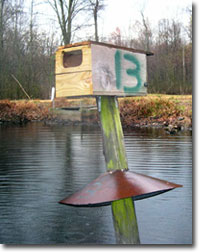 I had read from the Wood Duck Society newsletters how bad
starlings could be. I had not experienced this problem in our
private 4 year old program. I was amused to read about starling
traps and other forms of harassment but nothing seemed very
practical for a necessarily remote and passive deterrence technique.
I recalled seeing reference to an old study where horizontal nest
structures made out of 12” galvanized pipe had been successfully
used. I then learned that Frank McGilvrey, retired USF&WS but still
active as volunteer project manager at the Patuxent Wildlife Refuge,
was one of the authors. I met Frank, got to observe horizontal boxes
up close and immediately made and installed some either made from
12” x 24” sewer pipe (12” galvanized material was not available) or
horizontal rectangles made by flipping several of the older wood
boxes sideways and adjusting the openings.
I had read from the Wood Duck Society newsletters how bad
starlings could be. I had not experienced this problem in our
private 4 year old program. I was amused to read about starling
traps and other forms of harassment but nothing seemed very
practical for a necessarily remote and passive deterrence technique.
I recalled seeing reference to an old study where horizontal nest
structures made out of 12” galvanized pipe had been successfully
used. I then learned that Frank McGilvrey, retired USF&WS but still
active as volunteer project manager at the Patuxent Wildlife Refuge,
was one of the authors. I met Frank, got to observe horizontal boxes
up close and immediately made and installed some either made from
12” x 24” sewer pipe (12” galvanized material was not available) or
horizontal rectangles made by flipping several of the older wood
boxes sideways and adjusting the openings.
Convinced that I could not do worse than zero ducklings, Chesapeake
agreed that for the 2006 season, besides trying eight horizontal
nests, we close the other vertical boxes in the reservoir in
proximity to each other and add new boxes all along the
woods-wetland margin surrounding most of the wetland. The concepts
were to eliminate all starling housing, assuming the horizontals did
their job, to offer wood ducks the woods’ margin boxes as an
alternative house that would be less attractive to starlings as
generally represented in other literature. Net capacity was
temporarily reduced in this wetland but we had installed other new
boxes elsewhere on the property and had hoped these actions might
help their utilization. (It was over 90%).
Result
Three of the 8 horizontal boxes were used and hatched. Starlings
did not enter any of them. Some starlings perched on the entrance on
one horizontal long enough to “poop” extensively but never went in.
The other woods’ margin boxes were almost all utilized and had
either normal or relatively small dump nests. We opened 4 of the
vertical boxes in late April. Two had successful wood duck hatches
without starling interference and two were starling nests. All of
the horizontal nests had been examined by wood ducks as rounded
depressions in the nest material clearly indicated.
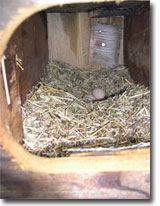 Perceptions thus far are that horizontal nests work and offer an
excellent way to thwart starlings. Based on only one season’s
observation, wood ducks do not seem to prefer these
nests over vertical; however, in heavy use areas, they appear to use them
readily. (3 other horizontal nests were installed in non-starling
prone areas. The nest boxes were examined; one had a drop nest but
none were successfully used).
Perceptions thus far are that horizontal nests work and offer an
excellent way to thwart starlings. Based on only one season’s
observation, wood ducks do not seem to prefer these
nests over vertical; however, in heavy use areas, they appear to use them
readily. (3 other horizontal nests were installed in non-starling
prone areas. The nest boxes were examined; one had a drop nest but
none were successfully used).
Research will continue and expand in 2007. After the initial
installation, I learned a few weeks later in the wooden horizontal
boxes that we needed to make
sure the back end of the horizontal nest was relatively dark to help
entice woodies to use them. Our opening holes in the wooden
horizontal boxes were also not 4” x 11”
as recommended in the article which I also got belatedly. The wooden
rectangle horizontal openings (4 of the 8) were roughly 6” x 8”.
Nest use was split evenly between round sewer pipe and wooden
horizontals. Thus, our quality control was lacking somewhat but
we’re poised to rectify these minor aspects for next season.
It was also pointed out by Frank that he is fairly confident that it
is the size of the entrance hole and not the amount of light allowed
into the box that deters starlings. Patuxent Refuge continues to use
horizontals as part of their housing mix and enjoys about 65% use on
their 40 horizontal boxes without any starling issues.
Double vs. Single Box Effectiveness
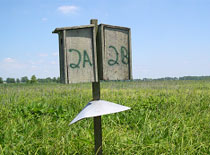 MWDI has begun a multi-year study to document
nest use & productivity from double box configurations compared
to single box mounts. Previously, it was an accepted resource
practice to mount multiple boxes on single poles due to cost and
maintenance efficiencies as the detrimental impact on
productivity caused by increased nest strife, lower hatch rates
and increased abandonment were not readily appreciated.
Clustering (i.e., placing boxes in relatively close proximity to
each other) whether single and double box mounts was also an
accepted practice for similar perceived efficiency reasons.
MWDI has begun a multi-year study to document
nest use & productivity from double box configurations compared
to single box mounts. Previously, it was an accepted resource
practice to mount multiple boxes on single poles due to cost and
maintenance efficiencies as the detrimental impact on
productivity caused by increased nest strife, lower hatch rates
and increased abandonment were not readily appreciated.
Clustering (i.e., placing boxes in relatively close proximity to
each other) whether single and double box mounts was also an
accepted practice for similar perceived efficiency reasons.
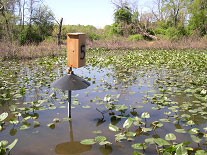 Today, while there is a greater appreciation
of the detrimental effects nest box clustering may have, the use
of double box mounts is still a common practice. As a result,
MWDI felt that it would be useful to evaluate whether this
practice had a positive, neutral or negative productivity impact
and under what circumstances it might be cost effective.
Today, while there is a greater appreciation
of the detrimental effects nest box clustering may have, the use
of double box mounts is still a common practice. As a result,
MWDI felt that it would be useful to evaluate whether this
practice had a positive, neutral or negative productivity impact
and under what circumstances it might be cost effective.
Related to this analysis, especially where
overall nest dumping and strife are known to exist, MWDI will
increasingly experiment with delayed or staggered nest openings
of one of the double mounted boxes to see if this type of
“de-clustering” approach might yield beneficial results.
These are the type of studies that are
feasible and will become more statistically significant as the
state wide data base grows. Additional private program
participants are sought to join this study. Site specific and
sponsor data are kept confidential.
Bee Deterrence
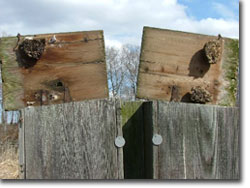 As an example of a relatively simple "cause and effect" study,
MWDI had read that soap rubbed on the inside roof on boxes thwarted
wasp nests. We tried it on about 50 boxes and it did work if applied
fully to cover the roof and if thick enough to fill the rough wood
seams. Some bees made nests on the side panel but these and any
other nests were all small (1-3 bees). We also found that it was
much easier to rub the roof before assembly so all corners could be
covered and knuckles were saved. We’re not sure it was necessary to
use deodorant soap as advertised but we did anyhow…Irish Spring!
As an example of a relatively simple "cause and effect" study,
MWDI had read that soap rubbed on the inside roof on boxes thwarted
wasp nests. We tried it on about 50 boxes and it did work if applied
fully to cover the roof and if thick enough to fill the rough wood
seams. Some bees made nests on the side panel but these and any
other nests were all small (1-3 bees). We also found that it was
much easier to rub the roof before assembly so all corners could be
covered and knuckles were saved. We’re not sure it was necessary to
use deodorant soap as advertised but we did anyhow…Irish Spring!